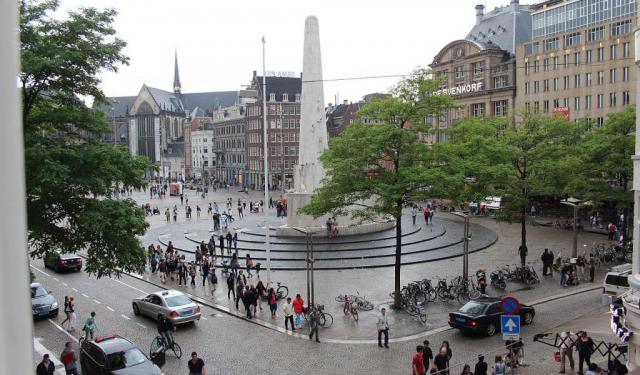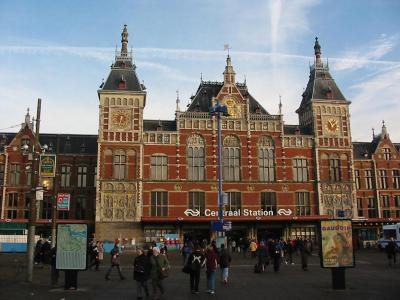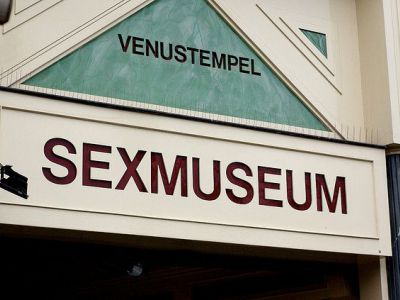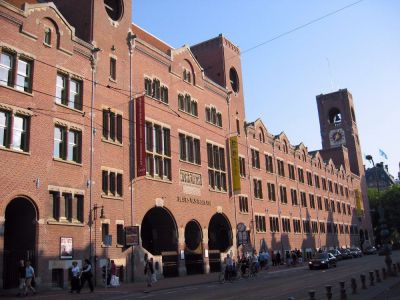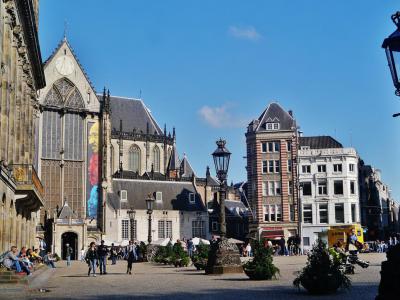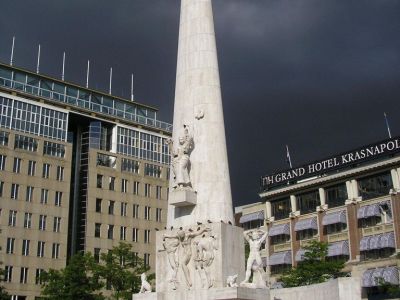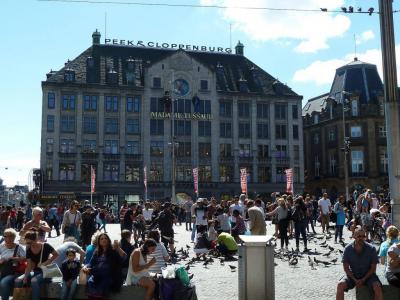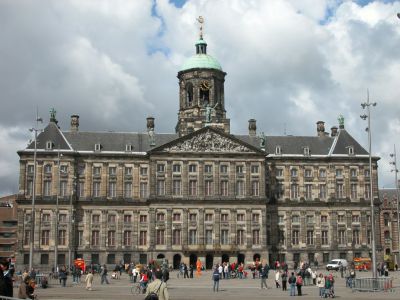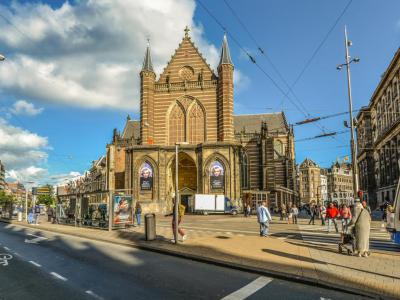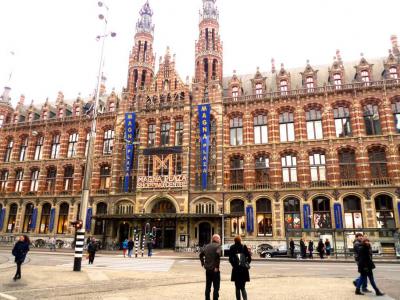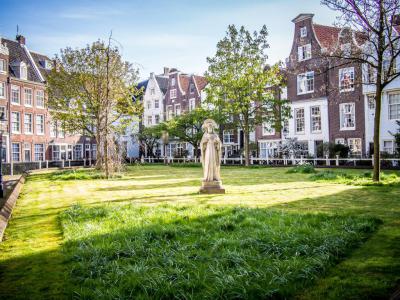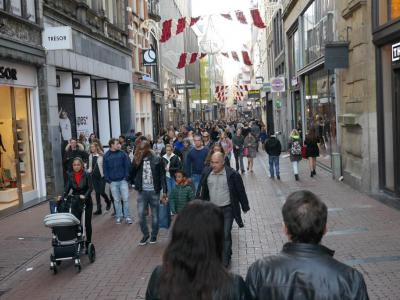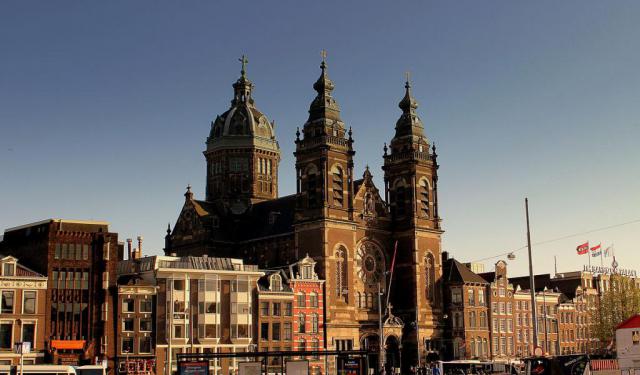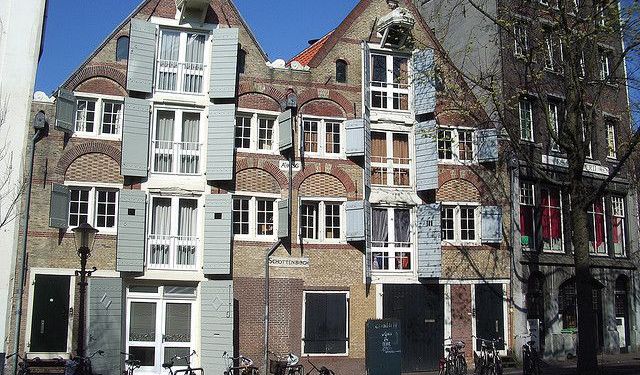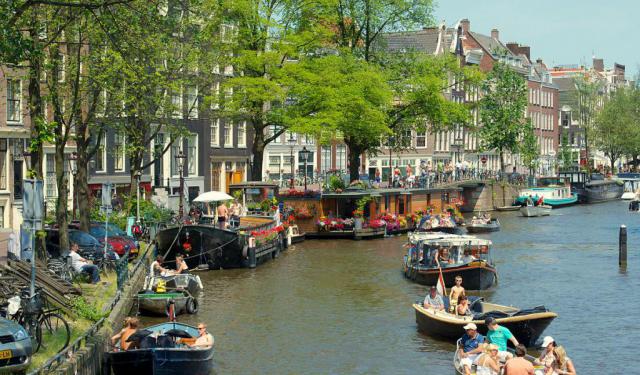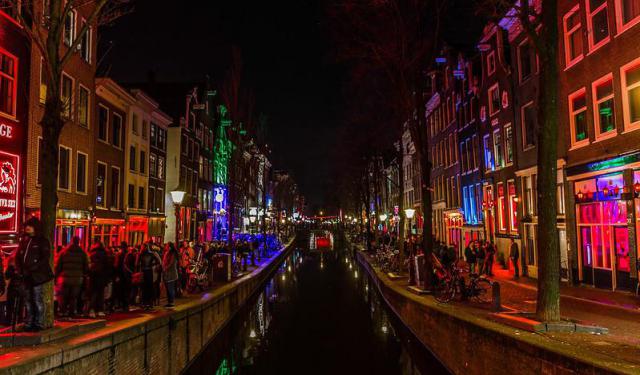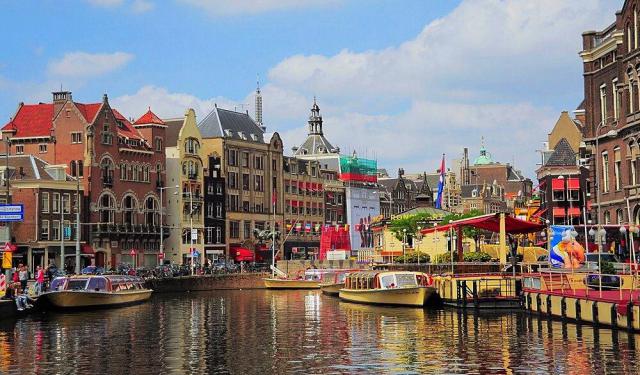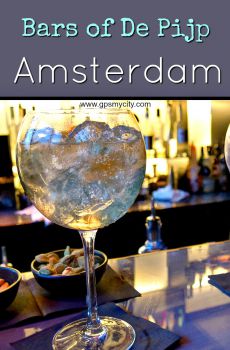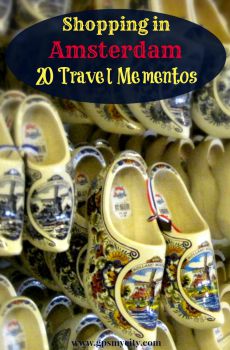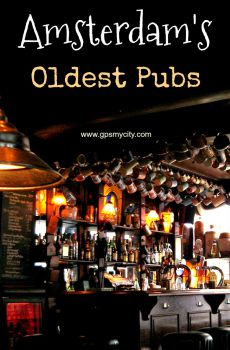City Center Walking Tour (Self Guided), Amsterdam
The inner-most borough and historic heart of Amsterdam, known locally as Centrum, is a tightly woven network of canals and overlapping micro-neighborhoods, each bursting with their own unique vibe and history. Formerly a working-class area, this district is reputed for its traditional community spirit, radical politics and historic brown bars.
Here, all within an easy walking distance you will find lively canal-side terraces packed to the brim with restaurants and bars, vintage shops and quirky, world-class museums, renowned cultural attractions and other notable buildings dotted around the charming, leafy cobbled streets, high-end shopping areas, and sprawling market squares.
Walking from the Central Station, Amsterdam's main public transport hub, you will soon find yourself at Dam Square – dominated by the neoclassical Royal Palace and 14th-century Gothic Nieuwe Kerk (New Church). Venturing further into the tightly clustered area you encounter more prominent sights, like Madame Tussaud's and the National Monument (an iconic World War II memorial) before ending on Kalverstraat – one of the most popular thoroughfares in Amsterdam, lined with flagship stores, restaurants and world-famous entertainment venues.
Beyond the best known attractions, there's also a treasure trove of hidden gems just waiting to be discovered, like Begijnhof – one of the oldest local hofjes (hidden courtyards).
If you're keen to “unearth” these and other cultural treasures in the historic center of Amsterdam, in your good time and at your own pace, take this self-guided walking tour.
Here, all within an easy walking distance you will find lively canal-side terraces packed to the brim with restaurants and bars, vintage shops and quirky, world-class museums, renowned cultural attractions and other notable buildings dotted around the charming, leafy cobbled streets, high-end shopping areas, and sprawling market squares.
Walking from the Central Station, Amsterdam's main public transport hub, you will soon find yourself at Dam Square – dominated by the neoclassical Royal Palace and 14th-century Gothic Nieuwe Kerk (New Church). Venturing further into the tightly clustered area you encounter more prominent sights, like Madame Tussaud's and the National Monument (an iconic World War II memorial) before ending on Kalverstraat – one of the most popular thoroughfares in Amsterdam, lined with flagship stores, restaurants and world-famous entertainment venues.
Beyond the best known attractions, there's also a treasure trove of hidden gems just waiting to be discovered, like Begijnhof – one of the oldest local hofjes (hidden courtyards).
If you're keen to “unearth” these and other cultural treasures in the historic center of Amsterdam, in your good time and at your own pace, take this self-guided walking tour.
How it works: Download the app "GPSmyCity: Walks in 1K+ Cities" from Apple App Store or Google Play Store to your mobile phone or tablet. The app turns your mobile device into a personal tour guide and its built-in GPS navigation functions guide you from one tour stop to next. The app works offline, so no data plan is needed when traveling abroad.
City Center Walking Tour Map
Guide Name: City Center Walking Tour
Guide Location: Netherlands » Amsterdam (See other walking tours in Amsterdam)
Guide Type: Self-guided Walking Tour (Sightseeing)
# of Attractions: 11
Tour Duration: 2 Hour(s)
Travel Distance: 2.3 Km or 1.4 Miles
Author: DanaOffice
Sight(s) Featured in This Guide:
Guide Location: Netherlands » Amsterdam (See other walking tours in Amsterdam)
Guide Type: Self-guided Walking Tour (Sightseeing)
# of Attractions: 11
Tour Duration: 2 Hour(s)
Travel Distance: 2.3 Km or 1.4 Miles
Author: DanaOffice
Sight(s) Featured in This Guide:
- Centraal Station
- Sexmuseum / Temple of Venus
- Beurs van Berlage (Old Stock Exchange)
- Dam Square
- National Monument on Dam Square
- Madame Tussauds
- Koninklijk Paleis (Royal Palace of Amsterdam)
- Nieuwe Kerk (New Church)
- Magna Plaza
- Begijnhof – Beguine Courtyard
- Kalverstraat (Calf Street)
1) Centraal Station (must see)
When in Amsterdam, a visit to the Central Station is practically inevitable. Nearly every traveler to the city encounters it at least once.
Amsterdam Centraal is the largest railway station in the city and has the second longest railway platform in the country, with a length of 695 meters, and a cast-iron platform roof spanning approximately 40 meters. A major international railway hub, it is used daily by almost 200,000 passengers, making it the Netherlands' most visited national heritage object.
Amsterdam Centraal was designed by Dutch architect Pierre Cuypers, featuring a blend of Gothic and Renaissance Revival elements.
The station was constructed on three artificial islands, between 1882 and 1889. Controversially located at the city's waterfront, it took a precise total of 8,687 wooden piles to anchor such a monumental structure on the marshy ground. The station spurred significant urban redevelopment and shifted Amsterdam’s focus from a waterfront to an inland city, influencing both transportation and city planning.
Its design celebrates Dutch economic and colonial prowess through various decorative elements. Initially, the entire project seemed like a huge blunder and was swiftly criticized by numerous experts. However, the architects persevered and ultimately vindicated themselves, defying skeptics.
Through the decades, Amsterdam Centraal has undergone multiple renovations and expansions to meet modern demands. Significant developments included the creation of a pedestrian tunnel in the 1950s, expansion of metro facilities in the late 1970s, and a major overhaul in the 1980s and 1990s that introduced new signaling systems, expanded tracks, and additional roofing. Recent upgrades focus on enhancing capacity and accessibility, including extended platforms for international trains, a new bus station, and upgraded retail spaces, marking it as a central hub in Amsterdam’s urban landscape.
Tip:
Take advantage of the several free ferry trips navigating the canals, departing every 5 to 15 minutes from this location; they offer a rewarding experience. You can even cruise back to the station via boat if you wish, rounding out your visit with a picturesque waterborne journey.
Amsterdam Centraal is the largest railway station in the city and has the second longest railway platform in the country, with a length of 695 meters, and a cast-iron platform roof spanning approximately 40 meters. A major international railway hub, it is used daily by almost 200,000 passengers, making it the Netherlands' most visited national heritage object.
Amsterdam Centraal was designed by Dutch architect Pierre Cuypers, featuring a blend of Gothic and Renaissance Revival elements.
The station was constructed on three artificial islands, between 1882 and 1889. Controversially located at the city's waterfront, it took a precise total of 8,687 wooden piles to anchor such a monumental structure on the marshy ground. The station spurred significant urban redevelopment and shifted Amsterdam’s focus from a waterfront to an inland city, influencing both transportation and city planning.
Its design celebrates Dutch economic and colonial prowess through various decorative elements. Initially, the entire project seemed like a huge blunder and was swiftly criticized by numerous experts. However, the architects persevered and ultimately vindicated themselves, defying skeptics.
Through the decades, Amsterdam Centraal has undergone multiple renovations and expansions to meet modern demands. Significant developments included the creation of a pedestrian tunnel in the 1950s, expansion of metro facilities in the late 1970s, and a major overhaul in the 1980s and 1990s that introduced new signaling systems, expanded tracks, and additional roofing. Recent upgrades focus on enhancing capacity and accessibility, including extended platforms for international trains, a new bus station, and upgraded retail spaces, marking it as a central hub in Amsterdam’s urban landscape.
Tip:
Take advantage of the several free ferry trips navigating the canals, departing every 5 to 15 minutes from this location; they offer a rewarding experience. You can even cruise back to the station via boat if you wish, rounding out your visit with a picturesque waterborne journey.
2) Sexmuseum / Temple of Venus
What started with skepticism has grown into one of Amsterdam’s most famous attractions. The city’s rich history and stunning art blend seamlessly with its exuberant erotic industry, and thus appeared the world’s very first Sexmuseum. Established in 1985, this unique institution draws over 500,000 yearly visitors, offering a fascinating look into the historical evolution of human sexuality. It’s a place where history meets curiosity, delving into the ways that desire and sensuality have shaped cultures through time.
Now, let’s be clear-this museum is strictly for adults; it’s not designed for children or families. The galleries feature an impressive variety of artworks, including paintings, sculptures, vintage photographs, and cartoons, all exploring the theme of erotica and sensuality. Additionally, you'll find personal artifacts, possessions, and documented histories of influential figures in the realm of sexuality. You can learn about the lives of figures like Madame de Pompadour, the famed mistress who seduced King Louis XV of France; the infamous Marquis de Sade, whose shocking exploits gave rise to the term “sadism”; and the legendary Mata Hari, a glamorous dancer whose name still conjures whispers of intrigue and espionage. Each of their stories weaves into a larger narrative, reshaping our understanding of sensuality, identity, and the complexity of human expression.
One particularly intriguing section dives into the practices of ancient civilizations, especially the Greeks and Romans. Here, you’ll find displays that explore their attitudes toward sexual norms, rituals, and deviations, in a way that’s both educational and entertaining.
In short, Amsterdam’s Sexmuseum is much more than a risqué novelty. It’s an engaging and informative experience that invites visitors to look beyond taboos and appreciate the complex, multifaceted history of human intimacy.
Now, let’s be clear-this museum is strictly for adults; it’s not designed for children or families. The galleries feature an impressive variety of artworks, including paintings, sculptures, vintage photographs, and cartoons, all exploring the theme of erotica and sensuality. Additionally, you'll find personal artifacts, possessions, and documented histories of influential figures in the realm of sexuality. You can learn about the lives of figures like Madame de Pompadour, the famed mistress who seduced King Louis XV of France; the infamous Marquis de Sade, whose shocking exploits gave rise to the term “sadism”; and the legendary Mata Hari, a glamorous dancer whose name still conjures whispers of intrigue and espionage. Each of their stories weaves into a larger narrative, reshaping our understanding of sensuality, identity, and the complexity of human expression.
One particularly intriguing section dives into the practices of ancient civilizations, especially the Greeks and Romans. Here, you’ll find displays that explore their attitudes toward sexual norms, rituals, and deviations, in a way that’s both educational and entertaining.
In short, Amsterdam’s Sexmuseum is much more than a risqué novelty. It’s an engaging and informative experience that invites visitors to look beyond taboos and appreciate the complex, multifaceted history of human intimacy.
3) Beurs van Berlage (Old Stock Exchange)
The grandeur of the Beurs, the historic Stock Exchange, famously known as the "Beurs van Berlage," designed by the prominent figure in Dutch Modern architecture, Hendrik Petrus Berlage at the turn of the 20th century, holds great fascination for those interested in city architecture. Berlage's creation marked a significant departure from the 19th-century historicism championed by Cuypers, opting instead for a style characterized by cleaner, more substantial lines influenced by Romanesque and Renaissance elements, while minimizing ornate details. This visionary approach foreshadowed the Expressionist movement that swept through northern Europe from 1905 to 1925, leaving a lasting impact. Considered ahead of its time, Berlage's designs stand out distinctly in Amsterdam's skyline.
Although the Beurs no longer serves its original commercial purpose, it has evolved into a venue for concerts, conferences, and exhibitions showcasing modern art and design. Nevertheless, the building itself remains the star attraction, notably featuring graceful shallow-arched arcades and intricate brickwork in the main hall.
Tip:
For those not inclined to opt for a guided tour, Berlage's architectural contributions can still be admired in the welcoming Bistro Berlage at the southern end of the building, adjacent to Beursplein, or at the Tony's Chocolonely Super Store (Oudebrugsteeg 15), where excellent dark chocolates are also on offer.
Although the Beurs no longer serves its original commercial purpose, it has evolved into a venue for concerts, conferences, and exhibitions showcasing modern art and design. Nevertheless, the building itself remains the star attraction, notably featuring graceful shallow-arched arcades and intricate brickwork in the main hall.
Tip:
For those not inclined to opt for a guided tour, Berlage's architectural contributions can still be admired in the welcoming Bistro Berlage at the southern end of the building, adjacent to Beursplein, or at the Tony's Chocolonely Super Store (Oudebrugsteeg 15), where excellent dark chocolates are also on offer.
4) Dam Square (must see)
Dam Square, or the Dam, is a central town square in Amsterdam, known for its significant buildings and frequent events. Positioned in the historical heart of Amsterdam, it sits on the site of the original dam on the Amstel River. The square extends some 200 meters from west to east and 100 meters from north to south, connecting Damrak and Rokin streets that trace the Amstel's original course.
The square is also the termination point for other notable streets like New Dike, Calf Street, and Dam Street, with the main red-light district, De Wallen, just beyond its northeast corner. Prominent features on Dam Square include the neoclassical Royal Palace, the 15th-century Gothic New Church, the Madame Tussauds Wax Museum, and the National Monument which honors World War II victims, all of which collectively turn the Dam into a major tourist hub.
The name "Amsterdam" originates from a dam built on the Amstel River around 1270. This dam, integral to the city's development, included a discharge sluice and later locks to facilitate navigation and control water levels. By 1275, the settlement was significant enough to be recorded in connection with a road toll granted by the count of Holland, Floris V. Over time, the dam expanded to accommodate a town square, now known as Dam Square. Eventually, the area became a hub for commercial and governmental activities, featuring a large fish market and a town hall.
Significant changes occurred over the centuries, including the demolition of a weigh house in 1808 to clear the view for Louis Bonaparte’s Royal Palace and the infilling of Damrak Avenue in the 19th century. The square also hosted the Beurs van Zocher stock exchange until 1903. Today, the De Bijenkorf department store has been in its place since 1914. Dam Square has also been a site for national events – such as the National Memorial Day commemorations at the National Monument unveiled in 1956, and public demonstrations, – maintaining its status as a national and cultural gathering spot for the Dutch.
Tip:
For those in need of a restroom, free and well-maintained toilets are available at the De Bijenkorf shop on the 5th floor.
The square is also the termination point for other notable streets like New Dike, Calf Street, and Dam Street, with the main red-light district, De Wallen, just beyond its northeast corner. Prominent features on Dam Square include the neoclassical Royal Palace, the 15th-century Gothic New Church, the Madame Tussauds Wax Museum, and the National Monument which honors World War II victims, all of which collectively turn the Dam into a major tourist hub.
The name "Amsterdam" originates from a dam built on the Amstel River around 1270. This dam, integral to the city's development, included a discharge sluice and later locks to facilitate navigation and control water levels. By 1275, the settlement was significant enough to be recorded in connection with a road toll granted by the count of Holland, Floris V. Over time, the dam expanded to accommodate a town square, now known as Dam Square. Eventually, the area became a hub for commercial and governmental activities, featuring a large fish market and a town hall.
Significant changes occurred over the centuries, including the demolition of a weigh house in 1808 to clear the view for Louis Bonaparte’s Royal Palace and the infilling of Damrak Avenue in the 19th century. The square also hosted the Beurs van Zocher stock exchange until 1903. Today, the De Bijenkorf department store has been in its place since 1914. Dam Square has also been a site for national events – such as the National Memorial Day commemorations at the National Monument unveiled in 1956, and public demonstrations, – maintaining its status as a national and cultural gathering spot for the Dutch.
Tip:
For those in need of a restroom, free and well-maintained toilets are available at the De Bijenkorf shop on the 5th floor.
5) National Monument on Dam Square
Crafted by the renowned Dutch architect Jacobus Oud, Dam Square proudly hosts a 22-meter (70-foot) tall obelisk, serving as a poignant memorial to the Second World War. Behind this solemn monument, urns hold soil collected from cemeteries and execution sites. The structure has become a national symbol, where each year, on May 4th, the Remembrance of the Dead ceremony takes place.
While this obelisk garners attention from numerous visitors, only a select few truly grasp its intricate symbolism. Adorned with exquisite details arranged in concentric circles, the obelisk features sculptures depicting men, howling dogs, and birds. On the front side, two male figures symbolize the Dutch Resistance Movement, while the left and right sides represent intellectuals and the working class, respectively. Dogs are emblematic of loyalty and suffering, while a woman with a child represents victory, peace, and new beginnings. Meanwhile, doves ascending to the skies symbolize freedom and liberation.
Why You Should Explore:
One of the most important European symbols that recall the immense tragedy of the Second World War. A tranquil spot for a brief pause while you explore other attractions in the vicinity.
While this obelisk garners attention from numerous visitors, only a select few truly grasp its intricate symbolism. Adorned with exquisite details arranged in concentric circles, the obelisk features sculptures depicting men, howling dogs, and birds. On the front side, two male figures symbolize the Dutch Resistance Movement, while the left and right sides represent intellectuals and the working class, respectively. Dogs are emblematic of loyalty and suffering, while a woman with a child represents victory, peace, and new beginnings. Meanwhile, doves ascending to the skies symbolize freedom and liberation.
Why You Should Explore:
One of the most important European symbols that recall the immense tragedy of the Second World War. A tranquil spot for a brief pause while you explore other attractions in the vicinity.
6) Madame Tussauds
Madame Tussauds Amsterdam, a prominent wax museum, is the first foreign branch of the iconic British institution. It first opened its doors in 1970. The museum was established by Josephine Tussaud, a businesswoman and direct descendant of Marie Tussaud, the founder of Madame Tussauds. Initially set up in Kalverstraat, the museum moved to the upper floors of the Peek & Cloppenburg building at Dam Square in 1991. This site is a national monument and was originally constructed between 1914 and 1917.
This museum showcases wax figures of celebrities across various categories, including the Golden Age of Dutch history, music, sports, and film. Noteworthy features include animated paintings and life-size statues of globally recognized figures like Michael Jackson and George W Bush.
Visitors can also experience themed interactive displays that have been updated since a modernization effort in January 2012. There, you can witness a moon landing walk through a dark passage that they say "joins life to death" and is forbidden to the most sensitive souls.
Tip:
Don't miss the opportunity to ascend to the top floor for a striking view of Dam Square!
This museum showcases wax figures of celebrities across various categories, including the Golden Age of Dutch history, music, sports, and film. Noteworthy features include animated paintings and life-size statues of globally recognized figures like Michael Jackson and George W Bush.
Visitors can also experience themed interactive displays that have been updated since a modernization effort in January 2012. There, you can witness a moon landing walk through a dark passage that they say "joins life to death" and is forbidden to the most sensitive souls.
Tip:
Don't miss the opportunity to ascend to the top floor for a striking view of Dam Square!
7) Koninklijk Paleis (Royal Palace of Amsterdam) (must see)
The Royal Palace of Amsterdam is a historic monument on Dam Square and is one of the four palaces in the Netherlands still left at the disposal of the Dutch Royal Family.
Its inception dates back to 1655. Back then, the city had recently thwarted William of Orange's attempts to subdue it and the city council sought a residence that would symbolize Amsterdam's municipal authority and pride. This led to a remarkably forward-thinking design-the Dutch interpretation of the classical principles revived during the Italian Renaissance. The architectural project led by Jacob van Campen implied over 13,500 wooden piles to support the building.
Initially designed as the town hall overlooking the bustling Damrak wharves, it was converted into a royal palace by King Louis I of Holland, brother of Napoleon Bonaparte, in 1806.
In 1936, the building was designated a property of the Kingdom of the Netherlands. Today, it serves a ceremonial role for the monarchy, hosting state visits, official functions, and award ceremonies. The palace also played a pivotal role during the investiture of Queen Beatrix in 1980.
The building's distinctive sandstone façade has darkened over time. Astride the rear of it is a 6-meter statue of Atlas carrying the globe.
The interior is equally opulent, notably in the Citizens' Hall, featuring an arcaded marble chamber where the enthroned figure of Amsterdam presides over the earthly and celestial realms. Three circular, inlaid marble maps, depicting the eastern and western hemispheres, as well as the northern sky, lie at her feet. Other allegorical figures include Wisdom and Strength, flanking "Amsterdam" on her left and right, while the reliefs on either side of the central group portray the principles of good governance. On the left, the god Amphion plays his lyre, persuading stones to form a wall; and on the right, Mercury seeks to lull Argos to sleep, thus emphasizing the importance of vigilance.
Tip:
Before your visit, be sure to check online for opening hours, as the palace may occasionally be closed due to royal events.
Free entry for those under 18 and discounts for seniors and students are available.
Its inception dates back to 1655. Back then, the city had recently thwarted William of Orange's attempts to subdue it and the city council sought a residence that would symbolize Amsterdam's municipal authority and pride. This led to a remarkably forward-thinking design-the Dutch interpretation of the classical principles revived during the Italian Renaissance. The architectural project led by Jacob van Campen implied over 13,500 wooden piles to support the building.
Initially designed as the town hall overlooking the bustling Damrak wharves, it was converted into a royal palace by King Louis I of Holland, brother of Napoleon Bonaparte, in 1806.
In 1936, the building was designated a property of the Kingdom of the Netherlands. Today, it serves a ceremonial role for the monarchy, hosting state visits, official functions, and award ceremonies. The palace also played a pivotal role during the investiture of Queen Beatrix in 1980.
The building's distinctive sandstone façade has darkened over time. Astride the rear of it is a 6-meter statue of Atlas carrying the globe.
The interior is equally opulent, notably in the Citizens' Hall, featuring an arcaded marble chamber where the enthroned figure of Amsterdam presides over the earthly and celestial realms. Three circular, inlaid marble maps, depicting the eastern and western hemispheres, as well as the northern sky, lie at her feet. Other allegorical figures include Wisdom and Strength, flanking "Amsterdam" on her left and right, while the reliefs on either side of the central group portray the principles of good governance. On the left, the god Amphion plays his lyre, persuading stones to form a wall; and on the right, Mercury seeks to lull Argos to sleep, thus emphasizing the importance of vigilance.
Tip:
Before your visit, be sure to check online for opening hours, as the palace may occasionally be closed due to royal events.
Free entry for those under 18 and discounts for seniors and students are available.
8) Nieuwe Kerk (New Church)
The New Church, a historical gem on Amsterdam's Dam Square, dates back to the 15th century. Originally serving as a Dutch Reformed Church parish, it is now part of the Protestant Church of the Netherlands.
The construction of this church in the late 14th century was prompted by a need for more religious space amid a growing population. It was completed in 1408 and consecrated a year later. Throughout the 15th century, the building suffered significant damage from fires and was nearly destroyed in 1645, which ultimately led to its Gothic-style reconstruction. Major renovations in the late 19th and mid-20th centuries introduced neo-Gothic and early-Renaissance elements.
The intricately adorned stained glass windows portray historical events associated with this church, such as Queen Wilhelmina's coronation in 1890. Notable features within the interior encompass an opulent, meticulously crafted mahogany pulpit (the result of fifteen years of painstaking effort), alongside a cunningly wrought copper chancel screen and a flamboyant Baroque organ case.
Historically significant, the New Church has hosted Dutch royal investiture ceremonies, including the most recent one of King Willem-Alexander, in 2013. It also has been the venue for royal weddings, such as Willem-Alexander's marriage to Máxima in 2002. Additionally, it serves as the final resting place for notable Dutch personalities like the naval hero Admiral Michiel de Ruyter and Joost van den Vondel, a Roman Catholic poet and playwright.
Although the church is still used for recitals, it no longer holds religious services but functions primarily as an exhibition space. The exhibitions held here cover diverse themes, including some rather unconventional ones. Attached to the church is a café accessible during opening hours and a museum store that offers a variety of related souvenirs like postcards, books, and gifts.
Tip:
Feel free to step inside the lobby to marvel at the beautiful giant stained glass panes.
Exhibitions can be a little overpriced but are good value with the I Amsterdam card.
The construction of this church in the late 14th century was prompted by a need for more religious space amid a growing population. It was completed in 1408 and consecrated a year later. Throughout the 15th century, the building suffered significant damage from fires and was nearly destroyed in 1645, which ultimately led to its Gothic-style reconstruction. Major renovations in the late 19th and mid-20th centuries introduced neo-Gothic and early-Renaissance elements.
The intricately adorned stained glass windows portray historical events associated with this church, such as Queen Wilhelmina's coronation in 1890. Notable features within the interior encompass an opulent, meticulously crafted mahogany pulpit (the result of fifteen years of painstaking effort), alongside a cunningly wrought copper chancel screen and a flamboyant Baroque organ case.
Historically significant, the New Church has hosted Dutch royal investiture ceremonies, including the most recent one of King Willem-Alexander, in 2013. It also has been the venue for royal weddings, such as Willem-Alexander's marriage to Máxima in 2002. Additionally, it serves as the final resting place for notable Dutch personalities like the naval hero Admiral Michiel de Ruyter and Joost van den Vondel, a Roman Catholic poet and playwright.
Although the church is still used for recitals, it no longer holds religious services but functions primarily as an exhibition space. The exhibitions held here cover diverse themes, including some rather unconventional ones. Attached to the church is a café accessible during opening hours and a museum store that offers a variety of related souvenirs like postcards, books, and gifts.
Tip:
Feel free to step inside the lobby to marvel at the beautiful giant stained glass panes.
Exhibitions can be a little overpriced but are good value with the I Amsterdam card.
9) Magna Plaza
Magna Plaza is a grand 19th-century edifice located behind the Royal Palace on Dam Square. Constructed between 1895 and 1899, it showcases a blend of Neo-Gothic and Neo-Renaissance architectural styles. The building was designed by Cornelis Hendrik Peters and has been listed as a national heritage site of the Netherlands since 1974.
The structure is notable for its elaborate brick exterior adorned with polychromatic brickwork and dressed stone around windows and doors. The roof is distinguished by several dormers, each topped with crow-stepped gables, contributing to its nickname "Perenburg" (or “pear-castle”) due to the pear-shaped crowns atop its towers.
Originally serving as Amsterdam's central post office, the building symbolized the city’s economic resurgence in the late 19th century, a period marked by significant developments like the opening of the North Sea Canal and the hosting of a World's Fair in 1883.
In 1987, plans to transform this historic post office into a luxurious shopping mall were announced by Larmag, a Swedish real estate developer. The renovations, which began in 1991, involved meticulous exterior restorations and a complete rebuild of the interior while preserving the structural and decorative elements. Named after Larmag's CEO, Lars-Erik Magnusson, Magna Plaza opened on August 17, 1992, as a shopping center.
Today, Magna Plaza offers a shopping experience across four floors, complemented by several cafes and a variety of stores. Despite its commercial function, the building remains an architectural gem worth visiting for its aesthetic and historical significance alone.
The structure is notable for its elaborate brick exterior adorned with polychromatic brickwork and dressed stone around windows and doors. The roof is distinguished by several dormers, each topped with crow-stepped gables, contributing to its nickname "Perenburg" (or “pear-castle”) due to the pear-shaped crowns atop its towers.
Originally serving as Amsterdam's central post office, the building symbolized the city’s economic resurgence in the late 19th century, a period marked by significant developments like the opening of the North Sea Canal and the hosting of a World's Fair in 1883.
In 1987, plans to transform this historic post office into a luxurious shopping mall were announced by Larmag, a Swedish real estate developer. The renovations, which began in 1991, involved meticulous exterior restorations and a complete rebuild of the interior while preserving the structural and decorative elements. Named after Larmag's CEO, Lars-Erik Magnusson, Magna Plaza opened on August 17, 1992, as a shopping center.
Today, Magna Plaza offers a shopping experience across four floors, complemented by several cafes and a variety of stores. Despite its commercial function, the building remains an architectural gem worth visiting for its aesthetic and historical significance alone.
10) Begijnhof – Beguine Courtyard
The Beguine Courtyard of the Begijnhof Chapel, one of Amsterdam's most ancient hidden courtyards, holds the distinction of being the sole inner court in the city founded during the Middle Ages and situated within the Singel-the innermost canal of Amsterdam's circular canal system. Adorned with manicured gardens, this courtyard sits at medieval street level, which places it a meter lower than the rest of the old city center. As the name suggests, it originally belonged to a community of Beguines-laywomen leading a semi-monastic life dedicated to prayer and charitable endeavors.
A cluster of historical edifices, predominantly private residences, surrounds the courtyard. These are tall townhouses, characterized by the distinctive Amsterdam architectural style, accentuating the court's relatively secluded ambiance. Unlike most courtyards, the buildings here are not arranged in rows connecting one dwelling to another; instead, there are 47 traditional townhouses, many adorned with facades dating back to the 17th and 18th centuries. However, the structures themselves often have origins predating this period, with eighteen of them retaining their original Gothic wooden framework.
During medieval times, the courtyard was entirely encircled by canals, offering only one entrance accessible via a bridge. Today, remnants of this entrance, known as the Begijnesloot, are still visible, thanks to a restoration effort in 1907. The stone doorway prominently displays the figure of Saint Ursula, the patron saint of Amsterdam's Beguines. Meanwhile, the entrance on Spuistraat, which was constructed at a later date, underwent significant changes in the 19th century.
A cluster of historical edifices, predominantly private residences, surrounds the courtyard. These are tall townhouses, characterized by the distinctive Amsterdam architectural style, accentuating the court's relatively secluded ambiance. Unlike most courtyards, the buildings here are not arranged in rows connecting one dwelling to another; instead, there are 47 traditional townhouses, many adorned with facades dating back to the 17th and 18th centuries. However, the structures themselves often have origins predating this period, with eighteen of them retaining their original Gothic wooden framework.
During medieval times, the courtyard was entirely encircled by canals, offering only one entrance accessible via a bridge. Today, remnants of this entrance, known as the Begijnesloot, are still visible, thanks to a restoration effort in 1907. The stone doorway prominently displays the figure of Saint Ursula, the patron saint of Amsterdam's Beguines. Meanwhile, the entrance on Spuistraat, which was constructed at a later date, underwent significant changes in the 19th century.
11) Kalverstraat (Calf Street)
Calf Street is a pedestrian zone and a major shopping street, running for about 750 meters from Dam Square to Muntplein Square. Alongside are a number of notable locations such as the former Orphanage building (now housing the Amsterdam Museum), the Saints Peter and Paul church, and the Orphanage Gate.
The street traces its roots back to the 14th century when it was known as The Lane and served as the western dike of the Amstel River. Later, it came to be known as Calf Street after the cattle market that existed there from 1486 until 1629.
On 16 March 1345, a Eucharistic miracle (known as the Miracle of Amsterdam or the Miracle of the Host) occurred in the area. Upon receiving the Holy Sacrament and last rites, a dying man vomited The Host (or the Sacramental bread used in the Christian ritual of the Eucharist). According to liturgical regulations, The Host was then put into fire but miraculously “survived” and was retrieved from the ashes intact the following day. This miracle was quickly acknowledged and, eventually, a large pilgrim chapel, called the "Holy Site", was built on the spot where it occurred. Presently, this miracle is commemorated annually with a Silent Procession through Calf Street.
By the late 19th century, Calf Street was the first street in Amsterdam to be paved, fitted with electricity, and hosted the first public film screening by the Lumière brothers (in 1896). The V&D branch on Calf Street, opened in 1912, was the Netherlands' first real department store and the first to feature elevators and escalators.
Today, Calf Street is the most expensive shopping street in the Netherlands, with rent prices reaching up to 3,000 euros per square meter. It has approximately 150 shops including several department stores, such as Bijenkorf (Amsterdam's premier option), Peek & Cloppenburg, and Maison de Bonneterie. The five-story Kalvertoren shopping center adds about 40+ stores to the area. At Number 212, you'll encounter the ever-present and budget-friendly HEMA, established in 1926, offering affordable designer goods, practical clothing, stationery, kitchenware, and food items.
Calf Street also features a branch of the Waterstone's bookshop chain, at Number 152. On Rokin, is one of the standout shops – the PGC Hajenius tobacconist, at Number 96. If you have a penchant for Havanas from a well-maintained humidor or seek a traditional clay pipe as a souvenir, this establishment is sure to delight you.
Introduced in 1995, the Shopping Sunday regulation, allowing local shops to work on Sundays, has been drawing additional crowds to the area ever since.
The street traces its roots back to the 14th century when it was known as The Lane and served as the western dike of the Amstel River. Later, it came to be known as Calf Street after the cattle market that existed there from 1486 until 1629.
On 16 March 1345, a Eucharistic miracle (known as the Miracle of Amsterdam or the Miracle of the Host) occurred in the area. Upon receiving the Holy Sacrament and last rites, a dying man vomited The Host (or the Sacramental bread used in the Christian ritual of the Eucharist). According to liturgical regulations, The Host was then put into fire but miraculously “survived” and was retrieved from the ashes intact the following day. This miracle was quickly acknowledged and, eventually, a large pilgrim chapel, called the "Holy Site", was built on the spot where it occurred. Presently, this miracle is commemorated annually with a Silent Procession through Calf Street.
By the late 19th century, Calf Street was the first street in Amsterdam to be paved, fitted with electricity, and hosted the first public film screening by the Lumière brothers (in 1896). The V&D branch on Calf Street, opened in 1912, was the Netherlands' first real department store and the first to feature elevators and escalators.
Today, Calf Street is the most expensive shopping street in the Netherlands, with rent prices reaching up to 3,000 euros per square meter. It has approximately 150 shops including several department stores, such as Bijenkorf (Amsterdam's premier option), Peek & Cloppenburg, and Maison de Bonneterie. The five-story Kalvertoren shopping center adds about 40+ stores to the area. At Number 212, you'll encounter the ever-present and budget-friendly HEMA, established in 1926, offering affordable designer goods, practical clothing, stationery, kitchenware, and food items.
Calf Street also features a branch of the Waterstone's bookshop chain, at Number 152. On Rokin, is one of the standout shops – the PGC Hajenius tobacconist, at Number 96. If you have a penchant for Havanas from a well-maintained humidor or seek a traditional clay pipe as a souvenir, this establishment is sure to delight you.
Introduced in 1995, the Shopping Sunday regulation, allowing local shops to work on Sundays, has been drawing additional crowds to the area ever since.
Walking Tours in Amsterdam, Netherlands
Create Your Own Walk in Amsterdam
Creating your own self-guided walk in Amsterdam is easy and fun. Choose the city attractions that you want to see and a walk route map will be created just for you. You can even set your hotel as the start point of the walk.
Amsterdam's Historical Churches Walking Tour
The history of Amsterdam is deeply intertwined with its religious heritage. The city is home to several historical churches, each with its own unique charm and significance. These religious sites serve as both spiritual centers and architectural treasures that provide insight into the city's past.
Our walk starts in the Central Station area and leads you to visit the eight most prominent... view more
Tour Duration: 2 Hour(s)
Travel Distance: 3.8 Km or 2.4 Miles
Our walk starts in the Central Station area and leads you to visit the eight most prominent... view more
Tour Duration: 2 Hour(s)
Travel Distance: 3.8 Km or 2.4 Miles
Jewish Quarter Walking Tour
Welcome to Amsterdam’s Jewish Quarter, a neighborhood rich in history, tracing the ebb and flow of the city’s Jewish community. It all began in the late 16th and early 17th centuries, when Sephardic Jews fleeing persecution in Spain and Portugal found refuge here. With its relatively tolerant atmosphere, Amsterdam quickly became a sanctuary, and before long, Ashkenazi Jews from Central and... view more
Tour Duration: 2 Hour(s)
Travel Distance: 2.3 Km or 1.4 Miles
Tour Duration: 2 Hour(s)
Travel Distance: 2.3 Km or 1.4 Miles
Jordaan Walking Tour
The Jordaan district of Amsterdam is a popular neighborhood renowned for its charming, narrow streets, quaint courtyards, and picturesque canals. Replete with beautiful historic houses, many of which have been converted into cozy cafés, trendy boutiques, and art galleries, this district has a distinctive atmosphere that sets it apart from other areas in the city.
The Jordaan was originally... view more
Tour Duration: 1 Hour(s)
Travel Distance: 2.4 Km or 1.5 Miles
The Jordaan was originally... view more
Tour Duration: 1 Hour(s)
Travel Distance: 2.4 Km or 1.5 Miles
Red Light District Walking Tour
For centuries, Amsterdam’s Red Light District has been a source of endless intrigue. Its heart and the most historic section, De Wallen, is a fascinating blend of medieval charm and modern-day notoriety. Here, you’ll find timeworn canal houses leaning at curious angles, narrow cobblestone alleys lined with old bars, cozy shops, and a sprinkling of late-night establishments. And of course, the... view more
Tour Duration: 1 Hour(s)
Travel Distance: 1.8 Km or 1.1 Miles
Tour Duration: 1 Hour(s)
Travel Distance: 1.8 Km or 1.1 Miles
Amsterdam Introduction Walking Tour
The Dutch capital, Amsterdam, some say, “dances to its own beat.” Indeed, Amsterdam – where “hipness meets history” – has a rather unusual life rhythm and style, famously manifested in the air of legalized cannabis, coffee shops, and the Red Light District. In large part, this “air of freedom” attracts annually to the city over five million visitors.
As a small fishing village,... view more
Tour Duration: 2 Hour(s)
Travel Distance: 4.0 Km or 2.5 Miles
As a small fishing village,... view more
Tour Duration: 2 Hour(s)
Travel Distance: 4.0 Km or 2.5 Miles
Amsterdam Food Tour
Amsterdam's food scene is a delightful fusion of local traditions and global influences. Making your way through the interlocking canals, pretty bridges, and a maze of streets laden with diverse eateries and bars may easily render you hankering for a bite to eat and/or a drink to wash it down with.
The diverse culinary landscape of Amsterdam caters to a wide range of tastes and... view more
Tour Duration: 2 Hour(s)
Travel Distance: 2.6 Km or 1.6 Miles
The diverse culinary landscape of Amsterdam caters to a wide range of tastes and... view more
Tour Duration: 2 Hour(s)
Travel Distance: 2.6 Km or 1.6 Miles
Useful Travel Guides for Planning Your Trip
Top 7 Dutch Cheeses to Try in Amsterdam
Don't mind things turning a bit "cheesy" when in Holland. After all, this small country is renowned for its cheese manufacturing and successfully competes, in terms of cheese exports, with such economic giants as the United States and Germany. Amsterdam alone and its vicinities are...
Bars of De Pijp, Amsterdam
Sitting to the south of the Centrum (city centre) De Pijp area of Amsterdam is a fascinating mixture of trendy urbanites, students, immigrants and Amsterdammers. De Pijp has a long history as the Bohemian part of town, which is reflected in the different cafés of the area. There truly is something...
12 Traditional Dutch Foods You Must Try in Amsterdam
Cool climate, closeness to sea, and sense of adventure have made the Dutch what they are – skillful farmers, industrious seafarers and, generally, people with the taste for life and good hearty meal, whether it comes from the sea they live by or the land they set their feet on. All of this has...
Souvenir Shopping in Amsterdam: 20 Dutch Things To Buy
Tulips, red lights, weed... Other than these, there are plenty of good things to remember Amsterdam by. What's more, you can take home some of them quite legally. Look here to see what to buy in Amsterdam and...
The Oldest and Historic Pubs of Amsterdam
Amsterdam is a stunningly beautiful city, steeped in history, with hidden treasures and fascinating tales practically around every corner. Like all marvelous cities, Amsterdam has its share of dining and drinking establishments from the modern to the ancient. This guide will assist you in exploring...
Dutch Sweets and Pastries
Known primarily for their cheeses, the Dutch have proven just as passionate about their sweets and pastries, many of which have come about as a result of the centuries of colonial past that had infused Holland with Oriental flavors and ingredients. Blended with their own dairy-rich European...
The Most Popular Cities
/ view all
